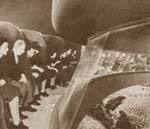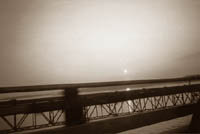 |
|
futurama, autogeddon |
|
Imagining the Superhighway from Bel Geddes to Ballard |
seven: autogeddon
[19] By the 1960s, however, cultural responses to the Interstate were beginning to change. Thirty years after the Futurama exhibition, J G Ballard penned The Atrocity Exhibition (1970), a dreamlike and fractured series of narratives which imagined near-future highways in a darker light. These generic highways, imagined by a British writer but realized in the nightmarish quality of the LA freeway system, Ballard called "Autogeddon": Waking: the concrete embankment of a motorway extension. Roadworks, cars drumming two hundred yards below. In the sunlight the seams between the sections are illuminated like the sutures of an exposed skull. (31)
[20] In his notes on The Atrocity Exhibition twenty years later, Ballard would observe that ... the car crash differs from other disasters in that it involves the most powerfully advertised commercial product of this century, an iconic entity that combines the elements of speed, power, dream and freedom within a highly stylized format that defuses any fears we may have of the inherent dangers of these violent and unstable machines. (97) Despite the preeminence of the automobile in this statement, though, something else is also going on in Ballard's text. The car is really secondary to the space in which it exists: the highway system itself. In fact, he suggests, "[t]he ultimate concept car will move so fast, even at rest, as to be invisible" (98). The Atrocity Exhibition imagines a world in which the highway has exhausted its own future, so that the world is re-presented as an extended moment; a car-crash which never ends but endlessly repeats, so that the space of the highway replaces the functioning of narrative time. |
| 1 |
| 2 |
| 3 |
| 4 |
| 5 |
| 6 |
| 7 << |
| 8 |
| 9 |
| 10 |
| credits |
| rhizomes |
 In
The Atrocity Exhibition, highways are refigured as a network of
fetishized sex and death -- their appeal no longer stemming from the glorious
vision of a streamlined future but rather from the inevitability of crash
culture. The book iterates road accidents, dismemberments and cut-up women's
bodies to create a crash future: "Sequence in slow motion: a landscape
of highways and embankments, evening light of fading concrete, intercut
with images of a young woman's body" (72). Aside from the gender implications,
in themselves troubling, Ballard's Autogeddon is a disturbing vision of
a near-future in which sex and death are rendered equivalent by the vertiginous
speed of the automobile; the highway, in other words, is haunted by death.
In
The Atrocity Exhibition, highways are refigured as a network of
fetishized sex and death -- their appeal no longer stemming from the glorious
vision of a streamlined future but rather from the inevitability of crash
culture. The book iterates road accidents, dismemberments and cut-up women's
bodies to create a crash future: "Sequence in slow motion: a landscape
of highways and embankments, evening light of fading concrete, intercut
with images of a young woman's body" (72). Aside from the gender implications,
in themselves troubling, Ballard's Autogeddon is a disturbing vision of
a near-future in which sex and death are rendered equivalent by the vertiginous
speed of the automobile; the highway, in other words, is haunted by death.